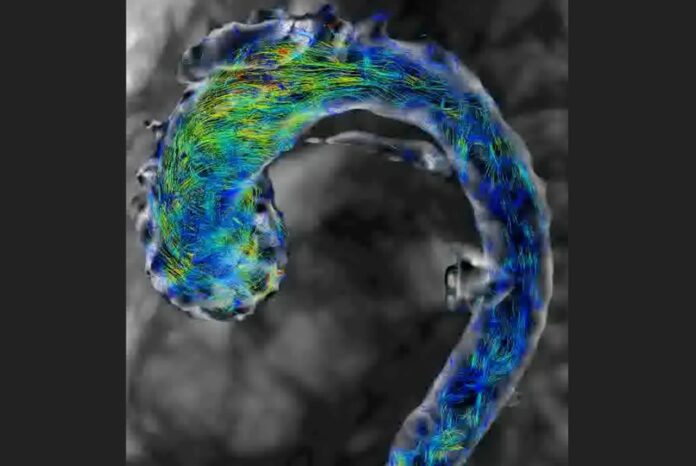Northwestern University researchers created a groundbreaking method to predict aortic aneurysms by measuring blood vessels “fluttering.” This subtle flutter, detected through a single 4D flow MRI scan, distinguishes between average and potentially dangerous aortic growth.
The researchers introduced the “flutter instability parameter” (FIP), predicting aneurysms with 98% accuracy, providing an early warning for a condition often asymptomatic until it becomes life-threatening. This innovation could revolutionize early detection and intervention for aortic aneurysms, offering a simple and effective diagnostic tool.
Doctors can use a predictive metric to identify high-risk patients for aortic aneurysm. This allows early intervention with medications to prevent dangerous swelling. The study was published in Nature Biomedical Engineering.
Northwestern’s Neelesh A. Patankar, the senior author of the study, said, “Aortic aneurysms are colloquially referred to as ‘silent killers’ because they often go undetected until catastrophic dissection or rupture occurs. The fundamental physics driving aneurysms has been unknown. As a result, there is no clinically approved protocol to predict them. Now, we have demonstrated the efficacy of a physics-based metric that helps predict future growth. This could be transformational in predicting cardiac pathologies.”
Patankar, a fluid dynamics expert and Northwestern professor co-led the study with biomechanics specialist Tom Zhao.
As it grows, the aorta’s wall weakens, and it ruptures when it can’t handle blood pressure anymore. Though rare, a rupture is often fatal and unpredictable. Notable people, like sports journalist Grant Wahl and celebrities John Ritter, Lucille Ball, and Albert Einstein, have died from aortic aneurysms.
Patankar said, “Most people don’t realize they have an aneurysm unless it is accidentally detected when they receive a scan for an unrelated issue. If physicians detect it, they can suggest lifestyle changes or prescribe medication to lower blood pressure, heart rate, and cholesterol. It can rupture, an immediate catastrophic event if it goes undetected.”
Zhao added, “If it ruptures when the person is outside of a hospital, the death rate is close to 100%. The blood supply stops, so critical organs like the brain can no longer function.”
Currently, doctors estimate the risk of an aortic aneurysm rupturing based on factors like age and aorta size. Regular imaging scans monitor a growing aorta; surgery might be needed if it proliferates. Mechanical engineer Neelesh Patankar emphasizes that “fluttering” is an automatic sign of future growth, helping predict aneurysms. This discovery could eliminate guesswork in monitoring aneurysm progression, preventing fatal bursts, and offering a more precise approach to intervention.
The researchers studied the physics underlying aortic aneurysm development. They combined factors like blood pressure, aorta size, wall stiffness, shear stress, and pulse rate to create a number (FIP). This quantifies the interaction triggering fluttering instability. Surprisingly, they found that less stiffness in the wall is linked to more risk for growth and rupture. This contradicts the common belief that aortic stiffness indicates disease. The study quantifies the risk factors involved, helping doctors understand and predict aortic aneurysm development more accurately.
Researchers used 4D flow MRI data from 117 heart disease patients and 100 healthy volunteers to validate the metric. Each patient received a personalized FIP, with zero as the stable-unstable threshold. An FIP below zero indicated unlikely abnormal aorta growth, while above zero suggested potential growth and rupture. Dr. Ethan Johnson, the study’s co-first author, highlighted the metric’s prognostic value in cardiovascular imaging, emphasizing its potential to enhance the standard of care for patients with aneurysms.
The researchers tested their predictions against follow-up MRIs and diagnoses, finding 98% accuracy. Although the FIP predicted future growth about three years later, it may offer a more detailed view of heart health daily or monthly.
The team plans to explore if FIP can offer insights into other heart conditions and if patient-specific FIP can guide effective prevention methods for aneurysm progression. The research, supported by the National Heart, Lung, and Blood Institute, demonstrates a promising step toward improving cardiovascular care and prevention.
“Fluttering instability” is a predictive marker for aortic aneurysms, offering a valuable tool for early detection and intervention. The study’s innovative metric, FIP, demonstrated 98% accuracy, showcasing its potential to improve cardiovascular care by predicting abnormal aortic growth. This research opens avenues for exploring heart conditions and tailoring prevention methods. The findings contribute to advancing medical understanding and enhancing patient-specific approaches to aneurysm management.
Journal reference:
- Zhao, T.Y., Johnson, E.M.I., Elisha, G. et al. Blood–wall fluttering instability as a physiomarker of the progression of thoracic aortic aneurysms. Nature Biomedical Engineering. DOI: 10.1038/s41551-023-01130-1.
